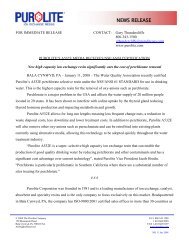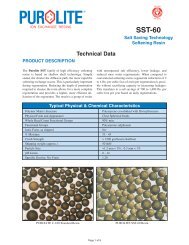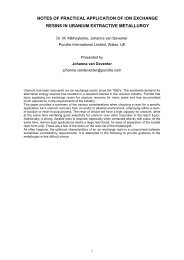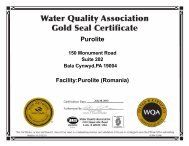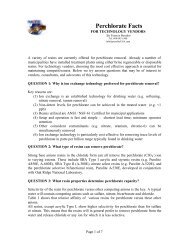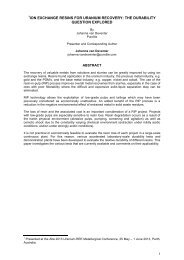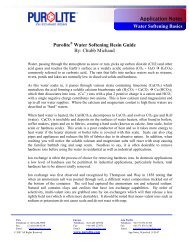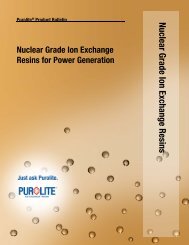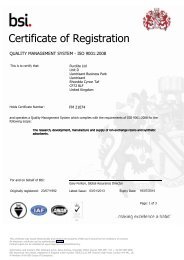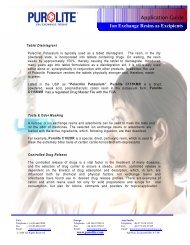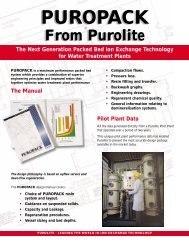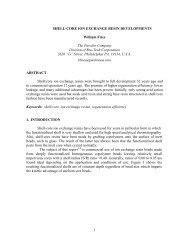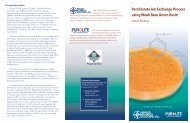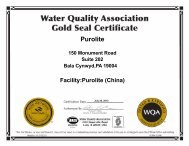PRODUCT INFORMATION Product Summary Guide - Purolite
PRODUCT INFORMATION Product Summary Guide - Purolite
PRODUCT INFORMATION Product Summary Guide - Purolite
You also want an ePaper? Increase the reach of your titles
YUMPU automatically turns print PDFs into web optimized ePapers that Google loves.
ADSORBENTSPUROSORBPOLYMERMATRIXPOREDIAMETERÅ*POREVOLUMEml/g*SURFACEAREAm2/dry g**MOISTURERETENTION%PAD350 Polystyrenic 350 0.7 700 58–64PAD400 Polystyrenic 400 0.7 720 55–61PAD428 Polystyrenic 450 0.7 500 50–56PAD500 Polystyrenic 620 1.0 700 63–69REMARKS & APPLICATIONSSpecifically designed for selective adsorption of molecules with arelatively low molecular weight, these adsorbents offer consistentenhanced performance over carbon and other adsorbents. Thevariations in surface area and pore volume give each product uniqueadvantages in applications such as the removal of hydrocarbons andchlorinated solvents from ground waters and industrial wastestreams.Brominated, styrenic adsorbent with high hydrophobicity. Removalof hydrophobic organic compounds from aqueous solutions andpolar solvents.This unique product, characterized by medium size pores and anarrow particle size distribution, offers definitive advantages overstandard grade adsorbents. Its uniform beads ensure lowerpressure drop in service duty and enhanced elution profiles of theadsorbed species on desorption. Typical applications include theextraction and separation of antocyans and polyphenols fromgrape must and other fruit juices.PAD550PAD600PolystyrenicPolystyrenic6006301.11.195083058–6458–64These three products differ in offering a range of surface areas,pore volumes and pore sizes specifically tailored for applicationswhere medium to large molecular weight species are targetedPAD700 Polystyrenic 700 1.2 550 56–62within the application. Typical applications include the isolationand purification of Active Pharmaceutical Ingredients.PAD900 Polystyrenic 1000 1.5 800 67–73PAD910 Polystyrenic 1100 1.6 540 62–68PAD300 Polyacrylic 280 0.5 90 59–65PAD610 Polyacrylic 700 1.1 490 60–66PAD950 Polyacrylic 960 1.3 535 65–71These products offer the largest pore sizes. They are designed tocapture the largest molecular weight speciesin a wide range of applications such as the extraction of antibioticsfrom fermentation broths or bitterness removal from citrus juices.The acrylic matrix gives these products different chemicalproperties. Their less hydrophobic structure enables them tooutperform polystyrene based synthetic adsorbents in non-polarmedia but does not mean they cannot be used in aqueous solutions.They have differing surface areas, pore volumes and poresizes to cover a wide range of applications. The changes in theseparameters alter the selectivity of each product.HYPERSOL-MACRONET ®MN100MN102TYPEWeak BaseAnionWeak BaseAnionVOLUMECAPACITYeq/l0.1 - 0.3(FB form)0.1 - 0.3(FB form)POREDIAMETERÅ*SURFACEAREAm 2 /dry g**900 900750 700MOISTURERETENTION%57–61(Cl - form)50–60(FB form)MN200 Inert — 900 900 57–61MN202 Inert — 750 825 50–60MN270 Inert — 25 1200 35–50MN500MN502Strong AcidCationStrong AcidCation0.8 - 1.0(Na + form)0.8 - 1.0(Na + form)900 900750 70052–57(H + form)52–57(H + form)REMARKS & APPLICATIONSFor the efficient sorption of high molecular weight color bodiessuch as those found in sugar solutions and many complexorganics such as dyestuffs or certain pesticides.For the efficient sorption of high molecular weight organicmolecules such as limonin and narangin from fruit juices.Regenerated more easily than other materials due to its weakbase functionality.For the efficient sorption of high molecular weight organicmolecules with lipophilic properties (dyestuffs, pesticides)in industrial process waste water treatment.For the efficient sorption of high molecular weight organicmolecules with lipophilic properties as are typically foundin waste waters from industrial processes. These includecomplex organics such as dyestuffs or pesticides.Sorption / Separation of hydrophobic organic species -Microporous matrix. Pore Volume 0.2 – 0.4 ml/g.Sorption / Separation of hydrophobic organic speciesSorption / Separation of hydrophobic organic species*Hg intrusion method**One point BET12



